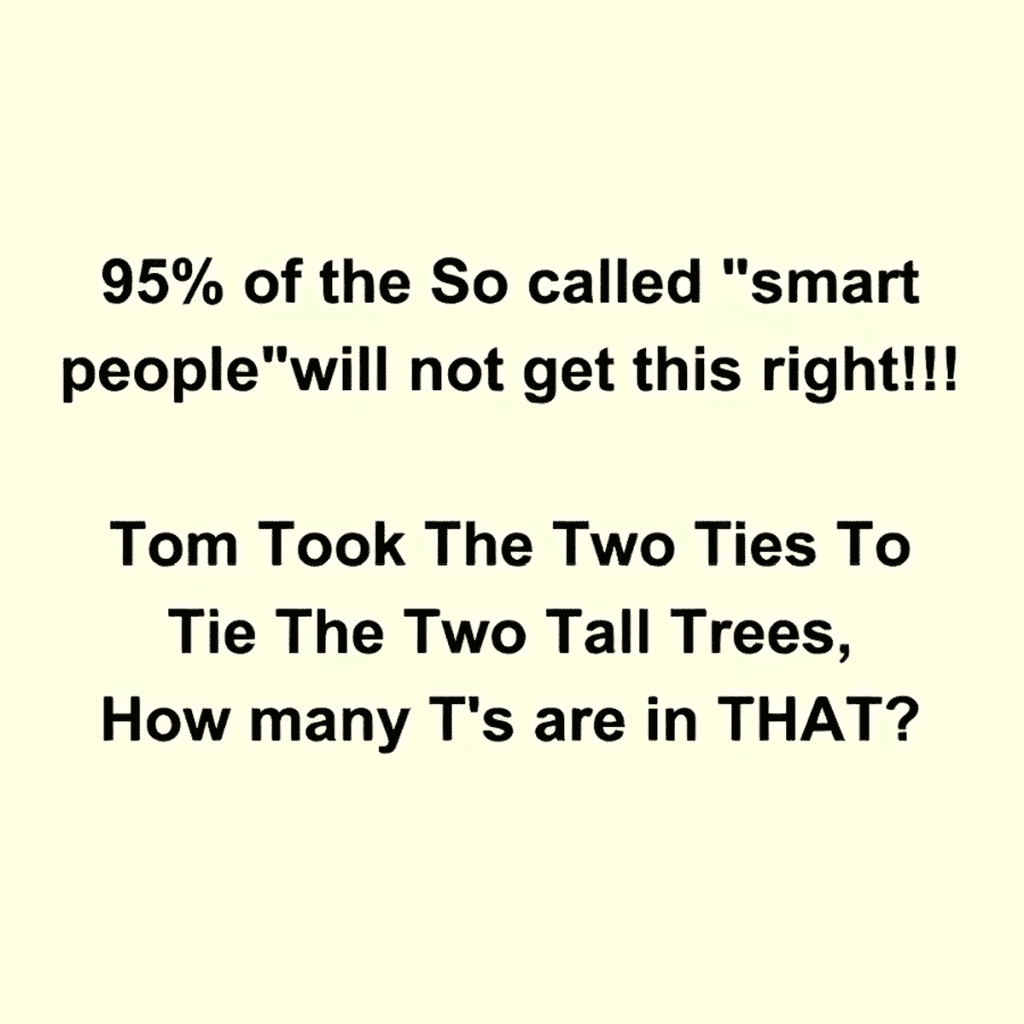Have you ever been completely outsmarted by a seemingly simple riddle? One that appears straightforward but leaves even the brightest minds scratching their heads? That’s exactly what happens with the famous riddle:
“Tom Took The Two Ties To Tie The Two Tall Trees, How many T’s are in THAT?”
Sounds easy, right? Think again. This riddle plays a clever trick on your natural instincts, testing your focus and critical thinking skills. Let’s break it down, explore the psychology behind it, and uncover why it confounds so many people—even those who consider themselves highly intelligent.

Why This Riddle Stumps Even the Smartest Minds
At first glance, this riddle seems like a simple word game. But its genius lies in how it manipulates your thought process. Here’s why most people get it wrong:
- Literal Thinking: Our brains are wired to take language at face value, especially when presented with a string of words like “Tom Took The Two Ties To Tie The Two Tall Trees.” Most people instinctively begin counting all the “T’s” in that phrase.
- Distraction by Details: The riddle’s wordiness distracts you from focusing on the actual question. It lures you into dissecting the sentence rather than paying attention to the final line: “How many T’s are in THAT?”
- Overthinking: Those who consider themselves smart tend to overanalyze. They look for patterns, hidden meanings, or complex tricks, often missing the simplest answer staring them in the face.
- The Power of Assumption: The question subtly guides you to focus on the wrong part of the riddle—the entire phrase—when the answer lies solely in the word “THAT.”
Breaking Down the Riddle
To understand why this riddle stumps so many, let’s break it down step by step:
Step 1: The Statement
“Tom Took The Two Ties To Tie The Two Tall Trees.” This sentence is designed to mislead. It’s full of “T”s, encouraging you to start counting them right away.
Step 2: The Question
“How many T’s are in THAT?” This is the twist. Instead of asking you to count the “T’s” in the full phrase, the question refers specifically to the word “THAT.”
Step 3: The Answer
The word “THAT” contains exactly two T’s—one at the beginning and one at the end. That’s it.
By the time most people realize this, they’ve already spent too much time focusing on the wrong thing. The simplicity of the answer is what makes it so brilliant.
The Psychology Behind the Trick
This riddle isn’t just a clever play on words—it’s a psychological masterpiece. It exploits some common mental habits, making it harder for people to arrive at the correct answer. Let’s dive into the psychology behind it:
1. Cognitive Overload
The sentence “Tom Took The Two Ties To Tie The Two Tall Trees” is deliberately long and repetitive. This overloads your brain with unnecessary information, making it harder to focus on the actual question.
2. Misdirection
The riddle relies on classic misdirection. It plants the idea that you need to count all the “T’s” in the phrase, diverting your attention from the key word: “THAT.”
3. Confirmation Bias
Once you start counting the “T’s” in the full sentence, your brain convinces itself that this must be the correct approach. It’s hard to step back and rethink the question when you’ve already committed to one interpretation.
4. Simplicity as a Barrier
Sometimes, the simplest solutions are the hardest to see. Our brains often equate complexity with intelligence, leading us to overcomplicate problems that have straightforward answers.
Lessons in Critical Thinking
This riddle isn’t just a fun brainteaser—it’s also a great reminder of the importance of critical thinking. Here’s what we can learn from it:
1. Pay Attention to Details
The answer was in the question all along: “How many T’s are in THAT?” By focusing too much on the sentence and not enough on the question, most people miss the obvious answer.
2. Avoid Jumping to Conclusions
It’s easy to assume you know what’s being asked without fully analyzing the question. Taking a moment to pause and think critically can save you from making avoidable mistakes.
3. Question Your Assumptions
Why did you assume the question referred to the entire phrase? This riddle teaches us to challenge our assumptions and consider alternative interpretations.
4. Simplify Your Approach
Sometimes, the simplest answers are the hardest to find. This riddle is a reminder that not every problem requires complex solutions—sometimes, less is more.
Why Riddles Like This Are So Entertaining
Riddles have been a source of entertainment for centuries. They’re not just fun—they’re also a fantastic way to exercise your brain. Here’s why riddles like this one are so engaging:
1. They Challenge Your Perspective
Riddles force you to think differently, helping you see things from new angles and question your usual thought patterns.
2. They Spark Friendly Competition
Who doesn’t love a good challenge? Sharing a riddle like this with friends or family can turn into a fun, lighthearted competition to see who can solve it first.
3. They Improve Cognitive Skills
Solving riddles enhances critical thinking, problem-solving, and attention to detail—skills that are valuable in everyday life.
4. They’re Universally Enjoyable
Whether you’re 10 or 50, riddles are a timeless form of entertainment. They’re simple enough for kids to enjoy but clever enough to stump even the smartest adults.
The Power of Wordplay
This riddle is a testament to the power of language. With just a few carefully chosen words, it creates a puzzle that’s both entertaining and thought-provoking. Wordplay like this highlights the versatility of language—it’s not just a tool for communication, but also for creativity and intellectual stimulation.
The riddle also reminds us of how easily words can be used to mislead or manipulate. In today’s world, where information is everywhere, this is a valuable lesson. Always read carefully, think critically, and don’t take things at face value.
Conclusion: Did You Get It Right?
The riddle “Tom Took The Two Ties To Tie The Two Tall Trees, How many T’s are in THAT?” is a masterclass in simplicity and misdirection. While many overthink or misinterpret it, the answer is right there in plain sight: two T’s in the word “THAT.”
This playful brainteaser is more than just a test of intelligence—it’s a reminder to slow down, think critically, and question your assumptions. So, next time you encounter a tricky riddle, take a moment to pause and really analyze it. You might just surprise yourself with how clever you really are!
Now, share this riddle with your friends and see if they can get it right. Will they fall into the same trap, or will they uncover the simple truth? Happy puzzling!



